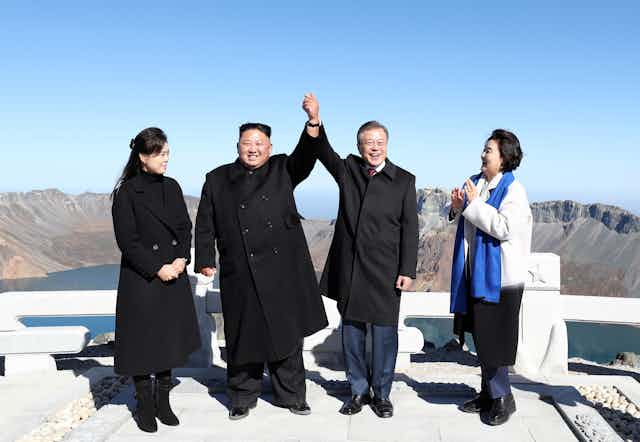Some 150,000 Pyongyang citizens gathered at the May Day Stadium recently to enthusiastically welcome Moon Jae-in – a South Korean president the North Koreans had long dubbed a follower or puppet of the “US imperialist aggressors”.
“No words can express my overwhelming delight as I see the people of Pyongyang warmly welcoming president Moon Jae-in and the delegates from the south … Please give another rousing round of applause for president Moon,” said North Korea’s supreme leader, Kim Jong-un.
Moon’s arrival on the stage was remarkable in itself, but things only progressed from there. Before his speech, he performed a “90-degree” bow to the audience. North Koreans usually bow in this style when they pay their respects to their three “dear leaders”, Kim Il-sung, Kim Jong-il and Kim Jong-un. The sight of a head of state bowing to them in the same way, especially a South Korean president, will have made a huge impression.
And that was before Moon got to the substance of the speech. Moon stressed that North and South Korea share the same bloodline; North Koreans were named “compatriots” (dongpo) six times in his seven-minute speech. Emphasising that “the destiny of Korean people would be in the hands of Korean people”, Moon pushed through a nationalistic crescendo to huge applause: “Korea is a great nation. We are strong people. And we should live together.”
Throughout his address, Moon wove together security-minded diplomacy with stirring nationalism. “Chairman Kim and I confirmed that our beautiful Korean landscape will be a place for living without nuclear weapons and nuclear threats,” he said, adding “before it becomes too late, we promised to take specific actions to put an end to the pains of separated families.”
This he did in the most conducive possible circumstances. Propaganda is the North Korean state’s most important political tool, and the Kim government stands out even among authoritarian regimes for successfully directing its propaganda towards its domestic audience. The lead act in its political theatre is always the supreme leader, whose words or “instructions” are absolute.
In this respect, what Moon was given in the stadium was not a mere microphone; it was the most powerful propaganda platform available. And what he did with it could radically change the way North Koreans think about their security.
A way out
For the last quarter of a century, North Korean society has been fed two dominant doctrines: “military first” (Songun) and “self-reliance” (Juche). Both of these fundamental political tenets, the state says, can only be realised via the development of a homemade nuclear deterrent. North Koreans are unremittingly subjected to such “nuclear warfare” propaganda – even if, in practical terms, what the weapons have ensured is less the development of the country than the endurance of the Kim dynasty and its hold on power.
This is why Moon’s “denuclearisation” speech could transform the north’s nuclear discourse. The Kim regime has survived by constantly stressing the need for security against “hostile environments” and thereby continuously justified its nuclear armament. Therefore, the rhetorical impact of such an emphatic declaration by Moon, with Kim applauding, cannot be underestimated: no discernible sign of hostility was visible.
Moon’s appearance in front of Pyongyang’s populace was reported by all the major North Korean state media, his “90-degree” greeting to ordinary Pyongyangers aired several times on North Korean Central Television. In this manner, albeit indirectly, Moon challenged North Koreans to reassess the sanctity of Songun and Juche in the light of a new, more hopeful reality. In other words, he managed not only to drive home the urgent importance of denuclearisation, but to undermine the very foundations of Pyongyang’s 25-year-old canon of nuclear propaganda.
Just as importantly, Moon’s speech planted the reunion of separated families firmly on the diplomatic agenda. The Kim regime has been reluctant to allow even fleeting reunions for families forced apart by the Korean War of 1950–1953. After all, if separated families regularly met and talked to each other, they would soon realise the economic and social gaps between the two Koreas – seriously weakening the north’s psychological hold on its population.
There is a vital lesson here for the entire Korean peace process. Focusing too closely on the details of the north’s nuclear technology – how many nuclear warheads it has, how many mobile missile launchers, how far the ballistic missiles can fly – could in fact get in the way of real denuclearisation. As things stand, the Kim regime needs effective nuclear propaganda to retain popular support. But if it can find a way not just to make real diplomatic progress with the south but also share the credit for it, Pyongyang might take the chance.
Just days after Moon made his unprecedented mass games speech, he met with Donald Trump in New York. That day, Trump publicly confirmed that a second meeting with Kim would take place “in the not too distant future”. If that does happen, he and his administration would do well to heed the example Moon has set. If the US wants to see Pyongyang dismantle its nuclear programme for good, it needs to find a way to signal to everyday North Koreans that their government’s hackneyed political propaganda – “the US imperialists, the sworn enemy of the Korean people” – is groundless.

